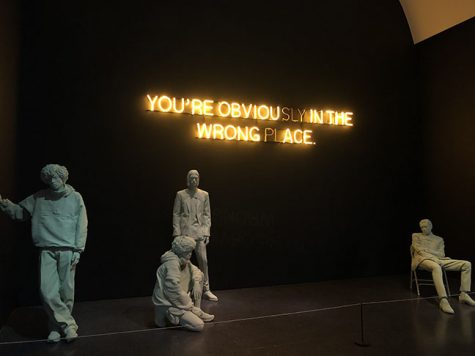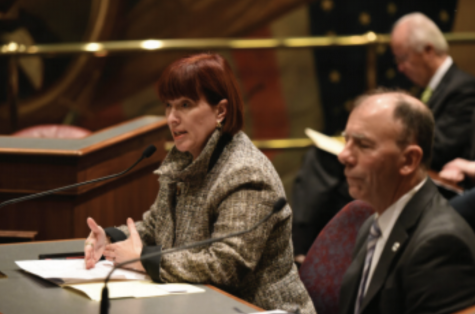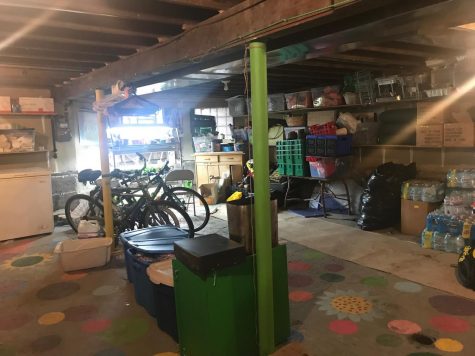Wrigley Rehab
Famous Chicago Ballpark Receives a Makeover
Wrigley’s famous marquee displays a game’s outcome after the Cubs defeat the Milwaukee Brewers 3-0. Photo by Celia Rattner.
A standout stadium for its crimson marquee, ivy-covered outfield, hand-operated scoreboard, and original green frame, Wrigley Field has been dubbed by many the “cathedral of baseball.” Wrigley’s home team, the Cubs were infamous for maintaining a 108 year championship drought–the longest in North American pro-sports history–until their World Series win in the fall of 2016. Since then, a number of ambitious developments have popped up around the stadium.
During games, the corner of Addison and Clark swarms with eager fans snapping selfies under the marquee and alongside the statue of former Cubs player Ernie Banks. Blue “W” flags draped on storefronts billow in the wind, and the smell of peanuts fills the air.
On off days, workmen in neon construction vests toil at reconstructing Wrigleyville buildings into modern hangouts for baseball fans and young bar-goers. Some welcome the rehabilitation with open arms, while others are skeptical.
The Cubs’ renovations began almost immediately after the 2016 win. In April of 2017, the Cubs owners, the Ricketts family, unveiled The Park at Wrigley, recently renamed Gallagher Way. Gallagher Way serves as an interactive plaza where both fans and passers-by can relax year round.
Outside of the ballpark on game days, Gallagher Way’s field is crowded with Cubs aficionados sporting blue and white jerseys. Families lounge around the lawn, enjoying picnics and watching the game displayed on a giant screen across the way.
During the offseason, Gallagher Way transforms into a winter wonderland complete with its own makeshift Christkindlmarket and skating rink.
Just north of the lawn are the Cubs’ office buildings. On the ground floor, fans file in and out of a sleek, new Starbucks and a Jeni’s Ice Cream, cheerfully purchasing snacks before and after games.
This coming summer, the spotlight will be on the Hotel Zachary, which opened in early April. Named after the architect of the original ballpark, Zachary Taylor Davis, the boutique hotel boasts luxury accommodations and a number of new eateries open to the public. A bakery, a barbeque joint, bars, a Big Star Taco, and a McDonalds, among other cuisine options, will be found at the 173-room hotel.
Many of those living around the ballpark are pleased with the hotel’s installation. “It’ll be so nice to have the Hotel Zachary with all those restaurants that we can walk to,” Tommy Sheridan, Parker parent and Wrigleyville resident, said. “Once they add the movie theaters and bowling alley, it’s going to be amazing.”
Not everybody is pleased. “Sure, Wrigley needed some revamping in terms of the field itself, but it was so iconic for being local, and we totally lost that feeling by rebranding the franchise,” sophomore and longtime fan Alex Ori said. “It’s lost its familiarity and its connection with fans.”
Wrigley is not the first stadium to usher in rapid changes post-championship. In 2005, Chicago’s other baseball team, the White Sox, won the World Series after a drought of nearly 90 years, and subsequently, U.S. Cellular Field, the home of the White Sox, received years of renovations costing $85 million, according to Forbes. In 2016, the stadium was renamed Guaranteed Rate Field, which was met with protest from some Sox fans.
The Boston Red Sox experienced a similar phenomenon following their 2004 World Series title after a near century without a championship. According to “The Boston Business Journal,” Fenway Park, the oldest ballpark in the country, added $285 million in restorations and extensions. This included expanded concession and merchandising stands, seating, and bathroom facilities.
The Ricketts family has spent close to $1 billion–most of it privately funded–in efforts to revamp the Wrigley experience, including $750 million on a five-year plan to upgrade the ballpark, according to “The Chicago Tribune.” In a statement Tom Ricketts made to a fan during an event for the Special Olympics’ 50th anniversary, he said, “This is my and my family’s legacy: to make this a better neighborhood, a better place to live, and a better place to be on game days.”
Some critics see the Ricketts’ developments differently. “Tom Ricketts has taken over,” Ebony Kenny, a Parker Quest employee who also works Wrigley concession stands, said. “It’s not Wrigleyville anymore–it’s Rickettsville. He bought everything. Change is good, but they’re doing a little too much change at one time.”
Ori agrees. “I had this relationship with the Cubs that they were my team because Wrigley was just a stadium with a McDonalds and a Taco Bell down the street,” Ori said. “But after the championship, their persona changed, and they were this ‘unbeatable team.’”
Others view the additions as necessary. “Wrigley Field was an old ballpark,” Sheridan said. “It needed to be renovated. We needed to build these venues and entertainment facilities because you want people to come and stay in the neighborhood, not just come to Cubs games.”
Like those of other baseball teams, the Cubs management has no plans of stopping their refashioning. A 148-apartment complex is currently being built, complete with a Shake Shack, bowling alley, movie theater, roofdeck pool, and other amenities. Further west on Addison, plans are underway to add a shopping outlet and gym in place of the Taco Bell.












